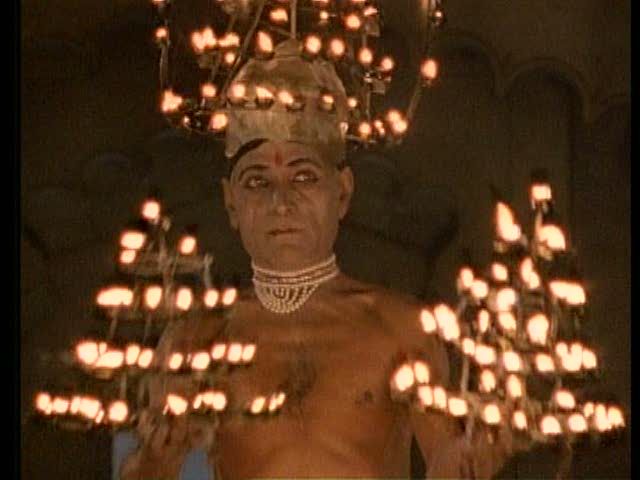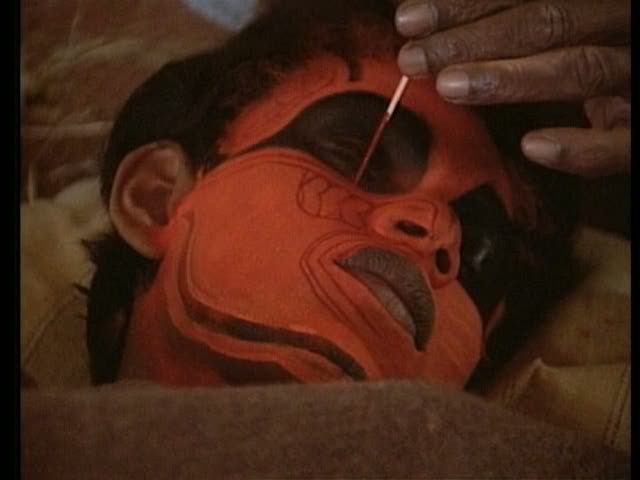
Werner Herzog's documentaries are rarely just passive recordings of real events; Herzog engages directly with the material of the world, shaping and crafting "reality" into an expression of his own personality and obsessions. As a documentary filmmaker, he thoroughly acknowledges the amount of artifice involved in creating these supposed "documents" of something happening in the world. Herzog's oeuvre is often divided between his documentaries and his fiction films, but there are few directors for whom that distinction means so little — in almost all of his work, fiction and reality weave together in complicated ways. This is certainly true also of Jag Mandir, a documentary about a folk art festival arranged in a remote region of India, though this film finds Herzog in more of a straightforward, ethnographic mode than usual. The film is presented as a record of a festival arranged by the Austrian actor, singer and conceptual artist André Heller, at the behest of a Maharajah who wanted his young son to witness the glory of Indian artistry before such local traditions were erased in the face of "McDonaldization."
This is such a typically Herzogian concept that it's difficult to accept the film's premise at face value. Yes, one supposes that Heller really did put together this grand showcase of Indian folk arts, but some of the ideas behind the project seem imposed by the Europeans, Herzog and Heller, rather than originating with the Maharajah himself, who is silent throughout. Early on in the film, Herzog holds his camera on a long closeup of the Maharajah, followed by a shot of his young son, but the director never interviews either of them or allows their voices into the film. They are silent presences, their true intentions and ideas a mystery. The audience is forced to take Herzog's word for it about the project's origins and intent, and though this is par for the course for Herzog's slippery, obtuse documentaries, it's vaguely troubling that he never allows in any actual Indian voices in a film supposedly dedicated to chronicling Indian culture.
The film opens with a lengthy introduction by Heller, in which he describes the exhaustive process by which he gathered the best and most interesting artists and performers from all around India and brought them together for this show. His rhetoric is overblown, an exaggerated account of the wonders he found, many of which cannot appear in the film because there were over 20 hours of footage in total. Some of these seem intended to create a sense of mysticism and spirituality, like the anecdote about a magician who can make himself disappear — not seen in the film, of course, perhaps because he's already invisible. This intro, coupled with Herzog's own voiceover during the early segments of the film, positions the film as a view of these wonders through European eyes, an outsider's perspective on this Indian art and theater.

After these introductory maneuvers, the bulk of the film is dedicated to a simple document of the show itself. Herzog's voiceover goes silent after a while, as one group of performers after another takes the stage, dancing, playing music, juggling and displaying an array of marvelous costumes. The whole thing is pure spectacle: there is doubtless a deeper meaning, either religious or cultural, to these displays, but Herzog is interested only in the gaudy surface, the beauty of the choreography, the texture of the makeup and costumes. The music, rhythmic and complex, is non-stop, much of it created through the intersections of dance and instrumentation. In many of these complicated choreographed pieces, the dancers contribute to the music by clacking together sticks or swords or playing the bells and cymbals affixed to their bodies. The stylized movements of the dancers thus perform a dual function, simultaneously visual and musical.
Other performers appear in animal costumes, with dancing lions or monkeys swaying to the rhythms of the music. But the most impressive performance is probably the simplest, a traditional dance that Herzog excerpts at great length towards the end of the film: a mixed group of male and female dancers who continually rearrange themselves into delicately pulsating tableaux vivant, often only allowing the fluttering motion of their hands to disrupt the stasis of their arrangements. It is a hypnotic, beautiful slow motion dance, driven by stop/start rhythms and subtle choreography. This is an especially straightforward film for Herzog because it seemingly exists wholly to document moments like this, to display the grandeur and beauty of these rituals and traditions. Jag Mandir is an interesting chronicle of a cross-section of Indian cultural artifacts, a document of various modes of expression and art that may be going extinct or disappearing from the cultural landscape of their own country.

No comments:
Post a Comment